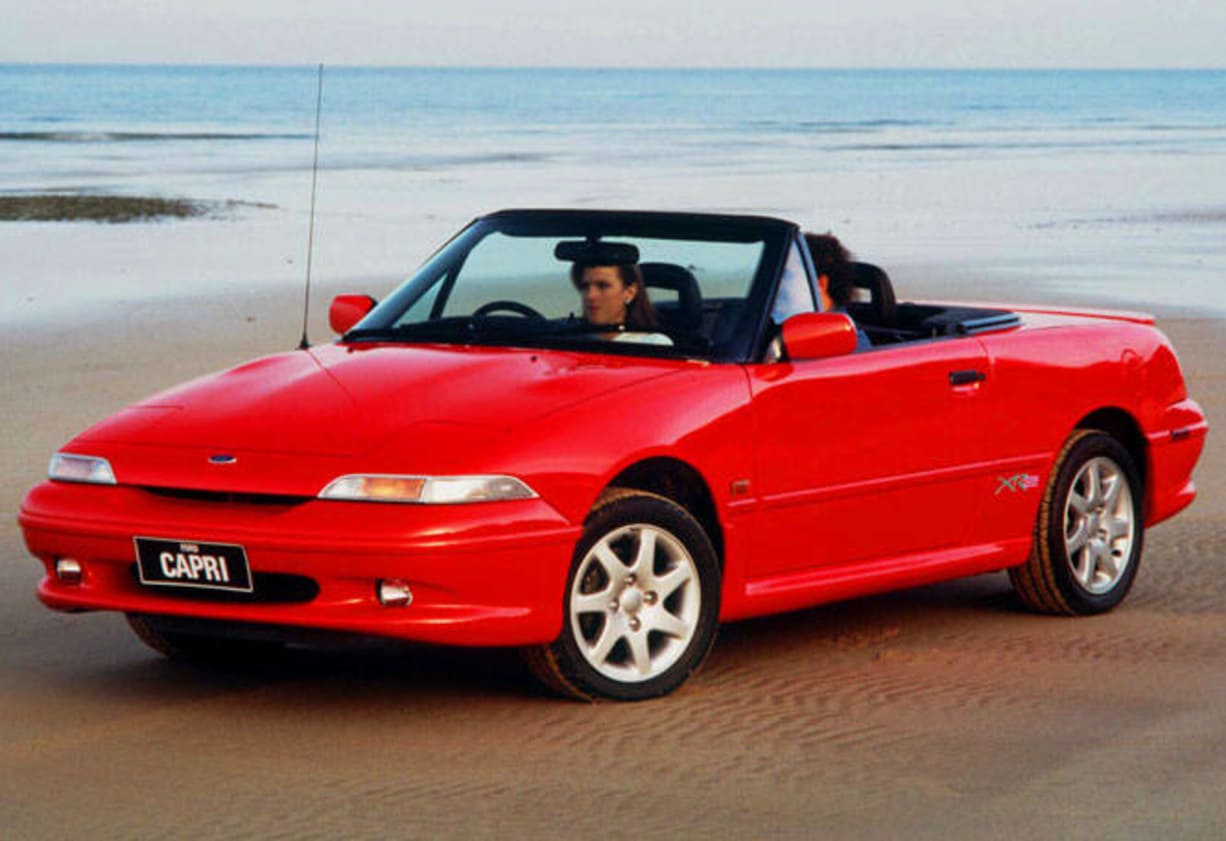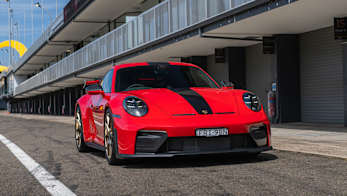The sight of Australian cars rolling up the loading ramps of ships bound for foreign lands is common today, but 1989 when Ford launched the Capri few Australian-built cars were exported abroad. In many ways the Capri was a ground breaking project that opened the door for other carmakers to walk through.
For carmakers facing tough times in the late 1980s it was case of ‘export or die’ and the Capri was Ford’s ticket to survival when it was becoming hard to justify large scale investment in a car like the Falcon that had little or no export potential.
A decade after the Capri experiment was called a failure it is Holden, not Ford that is exporting cars to the world. Ironically Holden is now sending the Monaro to the US, the very market Ford tried in vain to crack with the Capri.
The Capri began as a design concept in Europe, but it was Ford Australia that stepped up to the plate with an ambitious plan to build the car here and export it to the US where it would sell in sufficient numbers to make it financially viable.
It was a chance for Australian engineers, Ford’s in particular, to show the world they were capable of designing and building cars equal to those coming from anywhere in the world.
The odd thing is that the while the Capri built a solid and loyal following both here and in the US it is widely regarded as a lemon. There were some teething problems, most notably with the roof which leaked, but these were blown out of all proportion to the point owners became the butt of cruel jokes.
The truth is that Ford addressed the roof leak problems quite quickly, but it seems the critics couldn’t be satisfied and the ‘lemon’ tag stuck. It’s really an unfair tag, but one that holds Capri values back.
If you can ignore the ‘lemon’ tag the Capri is the least expensive way of enjoying the thrill of wind in the hair motoring.
MODEL WATCH
The Capri combined sexy Italian design, reliable Japanese powertrains and down home Aussie engineering in a convertible package conceived to conquer the US.
More a convertible cruiser than a sports car the Capri was a budget priced soft top that brought wind in the hair motoring within the reach of everyday motorists.
The two-plus-two design with its occasional rear seats meant it was possible to carry friends or kids; it had a clever folding roof, and safe front-wheel drive.
Initially power was from a fuel-injected 1.6-litre single overhead cam four producing a modest 62 kW at 5000 rpm, but this was replaced by a punchier 1.6-litre double overhead cam engine with the Series II in 1990.
The twin cam engine produced 77 kW at 6000 rpm, but for more zip Ford also offered a turbo version that boasted 100 kW at 5000 rpm.
A five-speed manual trans was the standard choice, with a three-speed auto as a softer option. A four-speed auto replaced the three-speed in 1990.
The SC model replaced the original SA in 1992 and this brought a greater model choice with the Barchetta, XR2, and the Tickford-tweaked Clubsprint with pearl black paint, turbo engine, sports body kit, and restyled front and rear.
The 1993 SE was the last of the line. The Barchetta had power steering, power windows and mirrors, cruise, and four-speaker radio/cassette; the XR2 added alloys, rear spoiler, driving lights, central locking and upgraded sound; the XR2 Turbo had manual trans only, turbo engine and sports suspension; the Clubsprint was available with turbo and non-turbo engine, body kit, driving lights, five-spoke alloys, leather trim and Momo steering wheel.
IN THE SHOP
The Capri copped plenty of criticism during its short production life. Coming at the same time as the Mazda MX5 it was inevitably, and somewhat unfairly, compared to the sportier Mazda.
Whereas the Mazda was developed as a pure sports car the Capri was developed with more emphasis on cruise comfort than an ability to round corners, so it inevitably came off second best against the MX5.
Sports car enthusiasts poured scorn on the Capri because it was front-wheel drive, but the handling was safe and responsive. Early turbo suffered from torque steer, which could be unpleasant under heavy acceleration.
Body twist was a fact of life with the Capri, but it was no more than would be experienced with other open cars of the time. It can lead to squeaks and rattles as the body loosens over time.
The Mazda engines and gearboxes give little trouble, same for the suspension and other mechanical components.
The main concern about the Capri was the well publicised issue of roof leaks on the early cars. It was mostly down to Ford’s use of local material for the roof, but when that split in service causing the roof to leak it was quickly replaced by a material imported from Germany, which fixed the leak problem.
Age is now the problem for the roof, so check carefully for rotten stitching, splits or wear in the roof covering where it folds, damaged seals, and discolouring or scratching of the rear window.
OWNERS’ VIEWS
Heather Watson bought her 1993 Clubsprint in 1997 with 50,000 km on the odometer. Admitting to a mid-life need for an open top car Heather, a francophile, was keen on the Peugeot 306 cabriolet, but when that exceeded her budget she turned to the Capri and hasn’t been disappointed in the 25,000 km she’s done since.
“I wanted something that was a bit of fun, easy to drive, comfortable and safe,” she says. “It’s been wonderful. I love driving it, it’s been very reliable and the roof hasn’t leaked.”
Peter and Nellie Flagg bought their ’92 Clubsprint turbo with 115,000 km on the odo. They’ve done 50,000 km and say it has been a delight to drive, is comfortable and the turbo motor is very responsive. The only problems have been an oil pump leak, a broken headlight base, and a slight water leak around the doors.
Michael and Mary Youngman have owned their 1993 turbocharged Capri for five years. They bought it with 47,700 km on the odo, which now reads 59,150. Long time sports car fans they say the Capri’s roof is only raised in exceptional circumstances. They say the Capri can’t be faulted, it has behaved beautifully, and the engine performs well.
Denise Stanford is the proud owner of a 1993 XR2 Capri, which has 92,000 km on the clock. It has been regularly serviced and apart from the usual fluids and filters only the front brake pads have had to be replaced so far. The roof has been waterproof until recently when age has started to catch up with it, with some stitching giving way, some glue losing its grip, and the fabric splitting where it folds. Her only complaint relates to the speakers, which she says weren’t adequate to overcome the wind noise when the roof was down, and now need replacing. Denise says there’s nothing better than to drop the top and purr along, sunscreen and hat in the summer, coat, scarf and the heater on in winter.
Jerry Rubinek has racked up 216,000 km in his a 1991 SA Series II Capri, and says it has been excellent. Jerry’s only gripe is with the lack of grunt when the air-con is operating, He’s replaced a headlight and has had a problem with the power windows, but he says there have been no problems with the roof.
As an engineer working at Ford on the project Maurie Eason was deeply saddened with the demise of the Capri, feeling that the problems with it had been solved. He liked it so much he bought a 1994 Barchetta, which is now 11-years-old with 122,000 km on it, and used daily by his wife. Mechanically he says it has been faultless, requiring only new tyres, front brake pads, and a new soft top after six years after exposure to the sun and rain finally got to the stitching.
LOOK FOR
• thrill of wind in the hair motoring
• safe and secure handling
• ageing of soft top with rotten stitching, tears, and fogged rear window on cars exposed to the sun and rain
• comfort with the convenience of occasional rear seating
• reliable Mazda mechanical package gives little trouble
Ford Capri 1989:
| Engine Type | Inline 4, 1.6L |
|---|---|
| Fuel Type | Unleaded Petrol |
| Fuel Efficiency | 9.5L/100km (combined) |
| Seating | 4 |
| Price From | $2,640 - $4,070 |










.jpg)

.jpg)



.jpg)
.jpg)